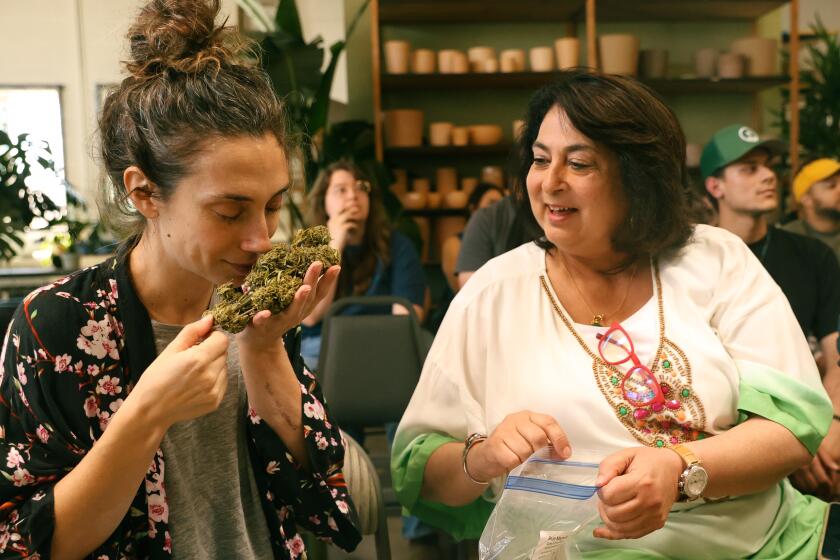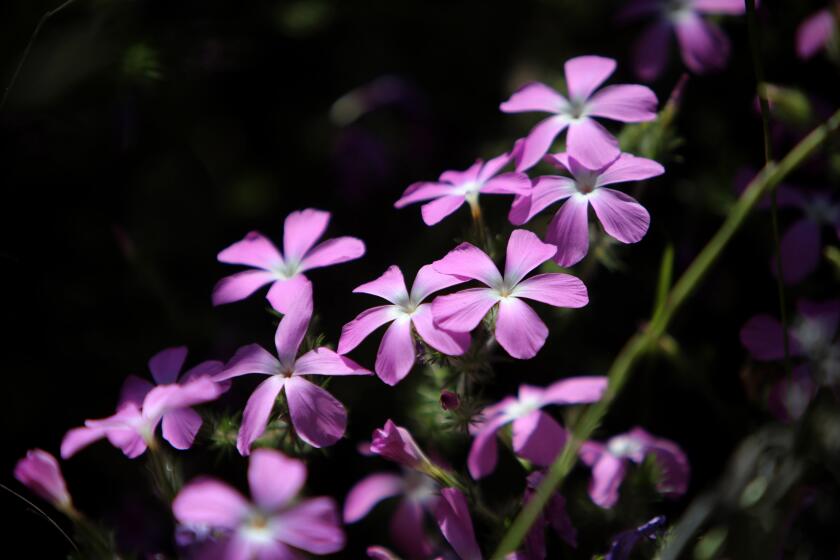Summer Gardens Are Getting Hotter
How about some hot colors for the hot weather ahead?
This is not the season for soft pink and misty blue. What’s needed are colors that shimmer in the heat, that won’t disappear in the glare of the midday sun.
Flaming red, ember orange, molten gold, sun yellow. These are the colors of summer, as hot as the sand at the beach. They also happen to be the colors of bedding plants that grow best in summer heat, so there are plenty at nurseries now.
What you want to plant now are zinnias, marigolds, gloriosa daisies, salvias, petunias, cosmos, gayfeather, verbena, portulaca, celosia, coreopsis, gaillardia and the like.
Is it too late to plant? Not at all.
These summer flowers grow fast and they’ll bloom through all the hot weather ahead, well into fall. Just be sure to water them every day the first week or so, until they get their roots into the soil.
Most are annuals--you plant them now, pull them out in late fall. A few are perennials, but you can plant them in with the annuals for a little variety. The brightest summer schemes mix both.
You can compose the garden while at the nursery, trying flowers out in the shopping cart, or on the ground in the aisles, to see what looks good with what. With such bright colors, potential aesthetic disasters are possible.
One of the hottest new colors is an almost fluorescent new zinnia named Classic Gold. Unlike most zinnias, this one doesn’t get all the pests and diseases, mildew in particular, according to Lillian Greenup at Sperling Nursery in Calabasas. It’s a slightly spreading plant to about 15-18 inches tall. There is also a cream in the Classic series, with more colors on the way.
Almost all zinnias are bright and sunny, like their native Mexico, even the pinks and roses. One about the same height as Classic Gold in Rose Pinwheel, and, in zinnia fashion, it’s a Day-Glo shade of this normally muted color. It is mildew resistant, if not immune.
Also look for the taller zinnias, for those back-of-the-border plants, but if mildew is a problem in your garden, be forewarned.
John Bauman at the Palos Verdes Begonia Farm thinks that Lady in Red is the hot ticket. This new salvia, an All-America Selection and Fleuroselect medal winner in Europe, is a dazzling orange-red. It’s growth is more open and upright than other bedding salvias, more like one of the perennial sages, but it only grows 15 inches tall.
Lew Whitney at Roger’s Gardens in Corona del Mar thinks Red Hot Sally is the best of the common, old-fashioned red bedding salvias. Cristin Fusano, the color specialist at Roger’s says that if you bump a salvia it will break, but they “bloom forever,” so be careful when planting and don’t let Rover run through the flowers.
The news here: the more muted but still strong shades, like the very handsome Burgundy, that mixes wine-red flowers with purple calyxs.
Another old favorite, the flame-like celosia has a New Look(that’s its name). This strain not only has red bright red feathery flower, but red leaves as well. You simply can’t get any hotter.
Unless it’s the Lady Bird cosmos. These are what the Begonia Farm calls the “other cosmos,” not the pink, lavender and white kinds so common in gardens, but those descended from Cosmos sulphureus, and the colors do look like a sizzling sulfur spring--deep mineral yellow, oranges and reds.
Cristin Fusano thinks a few perennials will add a little height and strength to a garden of bedding plants and suggests the deep red ‘Garnet’ penstemon as one to try. “People go right past the pink penstemon when this one is in bloom,” she says.
She also likes a sunflower relative named Heliopsis ‘Summer Sun’ that “you can see from the other side of the nursery” it’s so bright, and Roger’s is a big nursery. It will definitely bring height to the garden, growing to four feet tall with flowers 4-5 inches across.
Then there are the perennial coreopsis, perhaps better used as annuals because they get so shabby in winter but bloom so quickly. ‘Early Sunrise’ is the best of the bright, sun yellow double-flowered forms, to about 18 inches tall, but ‘Baby Sun’ is cuter and smaller, to only a foot, with single flowers.
One of Fusano’s favorite annuals is golden fleece. It’s so bright, “it looks like someone turned a spotlight on it,” she says. This is a short, front-of-the-bed flower, staying under six inches.
Even marigolds seem to be getting brighter. Take a look at Flame or Red Marietta. Bonanza Orange is one of Greenup’s favorites--a brilliant pumpkin orange.
With so many summer flowers to choose from, don’t you think it’s time to turn up the heat in the garden?
It’s Even Hot in the Shade
Bedding plants for the darker parts of the garden can also be bright. Impatiens keep getting louder, and Lew Whitney recommends planting mixes if you want the brightest look. Lillian Greenup recommends the Dazzler series--Punch in particular--and the Super Elfins. Both groups have fade resistant, “lipstick” colors and a very uniform habit of growth.
Whitney also likes the very bright Nonstop begonias. “They are much more floriferous than tuberous begonias,” he says. “Keep feeding and they keep flowering.” And coleus can bring bright color to dark areas with leaves that seem to glow in the shade.
Gardener’s Checklist
For dedicated gardeners, here are suggestions from the California Assn. of Nurserymen on what to do in the garden this week:
* Put shut-off valves on all your hoses to conserve water.
* Feed houseplants monthly. It’s their biggest growing season thanks to brighter light and more warmth. Move them back from western and southern facing windows to prevent burning.
* Set your mower blades higher. Use 2 1/2 inches for bluegrass lawns, 2 1/2-3 inches for tall fescue and 1 inch for warm season lawns such as Bermuda and Zoysia.



